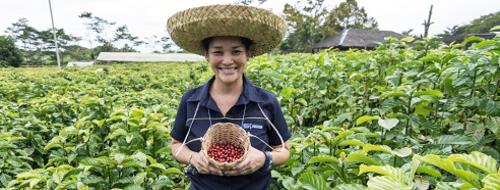In celebration of International Coffee Day on October 1, a contingent of 50 Nestlé Philippines employees went on a two-and-a-half hour trip to Barangay A. Dalusag in the municipality of Bailen (now Gen. Emilio Aguinaldo) in Cavite to show solidarity with real-life coffee farmers by doing actual work at their farms. These employees -- who came from Coffee and Creamer Creations Business Unit (3CBU), Corporate Affairs, Agri-Services, and Marketing, Communication and Innovation— spent the day under the sun pruning, weeding, and applying compost on coffee plants. This was their way of living up to the spirit of International Coffee Day, which was to accord recognition to coffee farmers.
“This first-hand experience made us realize just how hard it is to farm coffee from the soil,” said Dennis Austriaco, 3CBU Business Executive Officer. “It gave us a deep appreciation of the considerable effort, perseverance, and time that our farmers devote so that we at Nestlé can in turn manufacture NESCAFÉ for people to enjoy whenever and wherever they may be. This was a fitting occasion for us to thank our coffee farmers for what they do.”
The average Filipino coffee farmer is 57 years old and tills an average of 1 to 1.2 hectares of land, which he intercrops with coffee and other crops. Coffee is harvested once a year.
Coffee Farmers Face Challenges
Coffee farming is not an easy life and comes with its own set of challenges.
Nemencio Castillo, 57, said growing coffee alone would not enable survival so he, like other small-scale coffee farmers, practices intercropping with crops such as black pepper, banana and coconut on the two hectares of land that he takes care of. Costs of fertilizer and labor are high, he said, and labor supply is scarce. Today, there are no more young farmers as younger people prefer other means of livelihood. Without outside support, he added, growing coffee cannot be viable. He always worries about the price of coffee in the market. Coffee is a crop he inherited from his forebears and there was a time when coffee made a good life possible. He recounts that in the 1980s coffee prices were up and so farmers planted coffee.
Mario Bendo, 60, has been farming since 1987 when he left employment in Manila to manage his family’s farm. On several parcels of land totaling four hectares, he practices multi-cropping with coffee, coconut, santol, and black pepper. He is concerned about climate change, especially the occurrence of drought which kills crops. Coffee farming holds a deep meaning for him because he grew up with it, and it has provided a livelihood through time. Coffee has helped him raise his family and send his six children to school.
Amparo Rodrigo or Tatay Kiko, 55, with 20 years of farming to his name, has planted coffee, black pepper and guyabano in his 1.75 hectares. Volumes of harvest can vary. He is hopeful that this year’s harvest will be plentiful. With the high costs of fertilizer and labor, he does all the farm work by himself. Patience, he emphasizes, is a must.
Philip Gloriaga, 41, started farming in his youth and cultivates more than five hectares of land for coffee, coconut, and banana. He inherited coffee farming from his parents. Like his peers, he cites the high costs of fertilizer and labor as challenges that he must deal with.
The NESCAFÉ Plan
In order to assist farmers like those in Barangay A. Dalusag, Nestlé launched the NESCAFÉ Plan in 2010 as a global initiative to help ensure a sustainable supply of quality green coffee. Through this program, Nestlé Philippines aims to increase the supply of local Robusta coffee while helping farmers increase their yield and income from coffee. Through the NESCAFÉ Plan, coffee farmers can obtain superior quality plantlets at cost and avail of technology transfer through training across the country, a support network of agronomists, and strategically located buying stations close to coffee areas so more of them can have the opportunity to sell directly to Nestlé.
Under the program, an average of 10,000 Filipino coffee farmers are trained every year through NESCAFÉ Better Farming Practices (NBFP) Training Modules, consisting of an introduction to 4C or the Common Code for the Coffee Community, farm management and productivity, environmental conservation, health and safety, and green coffee bean or GCB quality and traceability. Between two Nestlé nursery facilities and four Department of Agriculture research centers, a total of four million coffee plantlets can be generated each year for distribution to farmers through government agencies. From 2013 to 2017, Nestlé Philippines has distributed 12,341,705 coffee plantlets.
Out of 34,000 Robusta coffee farms in the country, 14,000 are fully covered by Nestlé Philippines to date. From 2012 to 2017, Nestlé Philippines has purchased 55,962 metric tons of green coffee beans from local farmers, and its ambition is to source all its coffee beans from them eventually.
There is much more work to be done. Accordingly, the NESCAFÉ Plan is a long-term commitment, in line with Nestlé’s purpose of enhancing quality of life and contributing to a healthier future, for the sake of coffee farmers like Nemencio Castillo, Mario Bendo, Rodrigo Amparo, Philip Gloriaga, and their families.




